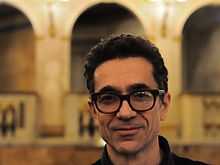Romeo Castellucci
| Romeo Castellucci | |
|---|---|
 Romeo Castellucci | |
| Born |
1960 Cesena, Italy |
| Occupation | Theatre director, playwright, artist, designer |
| Nationality | Italian |
| Period | 1981– |

Romeo Castellucci (1960 –) is an Italian theatre director, playwright, artist and designer. Since the 1980s he has been one part of the European theatrical avant-garde. He earned his diploma in set design and painting at the Accademia di Belle Arti di Bologna and founded along with his sister Claudia Castellucci and Chiara Guidi, the Societas Raffaello Sanzio.[1] Since then, the company has released more than a dozen books and has received numerous awards and recognitions. His company is considered to be one of the most radical contemporary theatre groups in Italy and in Europe.[1]
The company's performances are in the genre of the "Theater of Images" incorporating elaborate spectacles of theatre machines, dense soundscapes, and narrative fragmentation.[2] According to Contemporaryperformance.com the group's performers "are a mix of the Casellucci family, Italian actors, real performers of extreme age, size, or physical conditions, and animals."[2]
In 2003 he became director of the theatre section of the 37th edition of the Venice Biennale,[1] and in 2008 he was one of two "associate artists" at the Festival d'Avignon, and created three pieces inspired by Dante's Divine Comedy.[3] The trilogy was considered by the French newspaper Le Monde to be "the best play and one of the ten most influential cultural events in the world for the decade 2000-2010".[4]
Works
- Cenno (1981)
- Diade incontro a monade (1981)
- Persia-Mondo (1981)
- Popolo Zuppo (1982)
- I fuoriclasse della bontà (1983)
- Oratoria n.1: Rimpatriata Artistica (1983)
- Oratoria n.2. Raptus (1984)
- Oratoria n.3: Interferon (1984)
- Kaputt necropolis (1984)
- Glory glory, alleluja (1985)
- Santa Sofia. Teatro Khmer (1986)
- Oratoria n.4: Tohu Wa Bohu (Apparenze pre-mondiali) (1986)
- I Miserabili (1987)
- Oratoria n.5: Sono consapevole dell’odio che tu nutri per me (1987)
- Alla bellezza tanto antica (1988)
- Il gran reame dell’adolescenza [La cripta degli adolescenti, L’adolescente sulla torre d’avorio, Oratoria n.5.: Sono consapevole dell’odio che tu nutri per me] (1988)
- La discesa di Inanna (1989)
- Gilgamesh (1990)
- Iside e Osiride (1990)
- Ahura Mazda (1991)
- Amleto. La veemente esteriorità della morte di un mollusco (1992)
- Le favole di Esopo (1992)
- Masoch. I trionfi del teatro come potenza passiva, colpa e sconfitta (1993)
- Hansel e Gretel (1993)
- Lucifero. Quanto più una parola è vecchia tanto più va a fondo (1993)
- Oratoria n.6: con evidenza per coloro che intendono (1993)
- Persona (1994)
- Festa plebea con Oratoria n.7: anche il peggiore può parlare, ma non deve farlo per me (1994)
- Le fatiche di Ercole (1994)
- Orestea (una commedia organica?) (1995)
- Buchettino (1995)
- Pelle d'asino (1996)
- Giulio Cesare (1997)
- Ophelia (1997)
- La prova di un altro mondo (1998)
- Genesi. From the Museum of Sleep (1999)
- Voyage au bout de la nuit (1999)
- Il Combattimento dai Madrigali guerrieri et amorosi, Libro VIII (2000)
- Tragedia Endogonidia [C.#01 CESENA, A.#02 AVIGNON, B.#03 BERLIN, BR.#04 BRUXELLES/BRUSSEL, BN.#05 BERGEN, P.#06 PARIS, R.#07 ROMA, S.#08 STRASBOURG, L.#09 LONDON, M.#10 MARSEILLE, C.#11 CESENA] (2002-2004)
- Crescite [Dal Ciclo della TRAGEDIA ENDOGONIDIA] (2002-2004)
- Cryonic Chants (2004)
- Hey Girl! (2006)
- Divina Commedia: Inferno, Purgatorio, Paradiso (2008)
- Storia contemporanea dell'Africa. Vol. III (2008)
- Io penso (2010)
- Sul concetto di volto nel figlio di Dio (2010)
- Parsifal (2011)
- Il velo nero di pastore (2011)
- Persona (2011)
- Attore, il tuo nome non è esatto (2011)
- The Phenomenon Called I (2011)
- The Four Seasons Restaurant (2012)
- DAMMERUNG e NOTHUNG (2012)
- Folk (2012)
- Hyperion. Letters of a Terrorist (2013)
- Schwanengesang D744 (2013)
- Natura e origine della mente (2013)
Bibliography
- Colusso Tiziana, 1989. Società Raffaello Sanzio: Il Teatro Iconoclasta, Ravenna: Essegi.
- Castellucci Claudia & Castellucci Romeo, 1992. Il teatro della Socìetas Raffaello Sanzio. Del teatro iconoplasta alla super-icona, Milano: Ubulibri.
- Castellucci Claudia & Castellucci Romeo, 2001a. Les Pèlerins de la matière. Théorie et praxis du théâtre. Écrits de la Socìetas Raffaello Sanzio, Besançon: Les solitaires intempestifs.
- Castellucci Romeo & Guidi Chiara & Castellucci Claudia, 2001b. Epopea della polvere. Il teatro della Socìetas Raffaello Sanzio 1992-1999: Amleto, Masoch, Orestea, Giulio Cesare, Genesi, Milano: Ubulibri.
- Socìetas Raffaello Sanzio / Romeo Castellucci, 2003. Epitaph, Besançon: Les solitaires intempestifs.
- Tackels Bruno, 2005. Les Castellucci, Besançon: Les solitaires intempestifs.
- Castellucci Claudia & Castellucci Romeo & Guidi Chiara & Kelleher Joe & Ridout Nicholas, 2007. The Theatre of Socìetas Raffaello Sanzio, London: Routledge.
- Pitozzi Enrico & Saachi Annalisa, 2008. Itinera: Trajectoires de la forme. Tragedia Endogonidia, Arles: Actes Sud.
- Papalexiou Elena, 2009. Romeo Castellucci, Socìetas Raffaello Sanzio: When Words turn to Matter, Athens: Plethron.
- Papalexiou Eleni, 2012. « Le corps comme matière dramatique dans le théâtre de Romeo Castellucci », Utopie et pensée critique dans le processus de création, Les Solitaires Intempestifs, Besançon 2012, 75-88.
- Papalexiou Elena, 2011a. “Ecce Homo”, Theater der Zeit, Berlin, Januar 2011, 67.
- Papalexiou Eleni, 2011b. “The body as dramatic material in the theatre of Romeo Castellucci”, Prospero European Review. Theatre and Research, 2: 2011.
- Semenowicz Dorota, 2013. To nie jest obraz, Poznan: Fundacja Malta / Koproracja Ha!Art.
References
- ↑ 1.0 1.1 1.2 "La Biennale di Venezia - Sofia Gubaidulina and Romeo Castellucci to receive Golden Lions". http://www.labiennale.org. La Biennale di Venezia. April 30, 2013. Retrieved 1 September 2013.
- ↑ 2.0 2.1 "Featured: Romeo Castellucci / Socìetas Raffaello Sanzio (Cesena, Italy) Contemporary Performance". contemporaryperformance.com. August 7, 2012. Retrieved 1 September 2013.
- ↑ "ROMEO CASTELLUCCI / SOCÌETAS RAFFAELLO SANZIO - ASSOCIATE ARTIST - EDITION 2008 - ARCHIVE - Festival d'Avigno". http://www.festival-avignon.com. Festival d'Avignon. August 2008. Retrieved 1 September 2013.
- ↑ "Romeo Castellucci". http://www.mif.co.uk/. Manchester International Festival. August 7, 2012. Retrieved 1 September 2013.